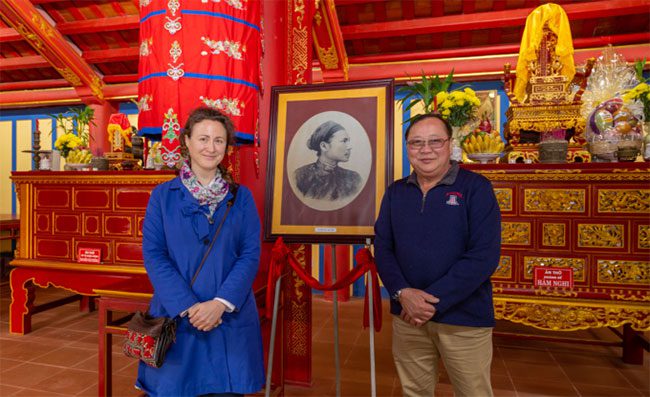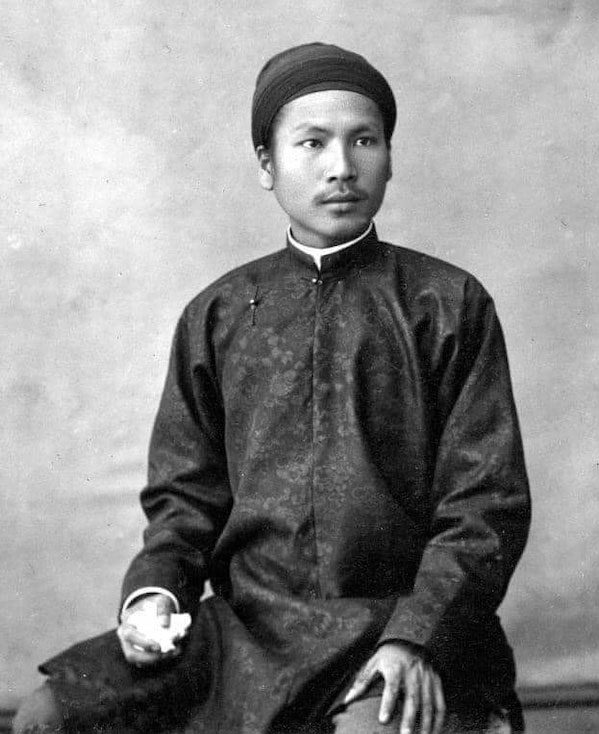The 4th and 5th generation descendants of King Hàm Nghi wish to bring the king’s remains back to his homeland as he expressed in his will.
On January 12, Mr. Đặng Văn Luyện (4th generation descendant of King Hàm Nghi) and Ms. Amandine Dabat (5th generation) visited the shrine dedicated to King Hàm Nghi and the Can Vuong generals at the national heritage site of Tân Sở, located in Cam Chính commune, Cam Lộ district.
The shrine is built on the grounds of Tân Sở, which was a reserve capital established by the Nguyễn Dynasty in 1883. On July 13, 1885, King Hàm Nghi issued a decree calling for the Can Vuong movement, urging citizens from all three regions to resist the French in order to “transform turmoil into stability, change danger into safety, and restore the nation’s borders.”
The descendants of King Hàm Nghi express their desire to return the king’s remains to his homeland. (Video: Anh Vũ – Hoàng Táo)
Ms. Amandine Dabat stated that in his will, King Hàm Nghi wished to be buried in his homeland, beside his biological father. However, when he passed away in 1944, due to Vietnam’s struggle for independence, the king’s wife was unable to fulfill his last wish. Later, his descendants wanted to keep his grave in France for easier access to pay respects.
“However, I and the younger generation wish to honor King Hàm Nghi’s final wish to return him to his homeland,” Ms. Amandine Dabat said, noting that they would wait for the appropriate time to fulfill this desire.
Mr. Đặng Văn Luyện also shares the wish to fulfill King Hàm Nghi’s wish for repatriation and “will do it when the previous generation allows.”

Ms. Amandine Dabat and Mr. Đặng Văn Luyện, two descendants of King Hàm Nghi, pose with a portrait of the king. (Photo: Hoàng Táo)
Recently, Mr. Luyện has returned to Vietnam several times, visiting Huế city and Quảng Trị, which are significant locations in King Hàm Nghi’s life. According to the Nguyễn Phúc Clan Council of Vietnam, he and his brother Đặng Văn Giáp donated 10 billion VND for the restoration of the Kiên Thái Vương Palace (in Huế, a shrine for five kings), which was inaugurated in February 2021.
During this visit to Vietnam, Ms. Amandine Dabat brought a pipe, a cherished item associated with King Hàm Nghi’s life, to donate to the Huế Monuments Conservation Center. She also promised to donate another pipe to the shrine of King Hàm Nghi and the Can Vuong generals during her next visit. This summer, she plans to introduce a Vietnamese-language book she wrote about King Hàm Nghi in Vietnam.
Three days ago, she attended the exhibition King Hàm Nghi: Life and Art at the Imperial Antiquities Museum in Huế and shared insights about the king’s life during his exile in Algeria until his death.

Self-portrait of King Hàm Nghi, 1896. (Archive photo).
According to the official history of the Nguyễn Dynasty, King Hàm Nghi’s real name was Nguyễn Phúc Ưng Lịch, the fifth son of Kiên Thái Vương Nguyễn Phúc Hồng Cai. From a young age, he lived in poverty with his mother, unlike his two brothers who lived in the palace, King Đồng Khánh and King Kiến Phúc. In 1884, King Hàm Nghi was enthroned at the age of 13 by the regents Nguyễn Văn Tường and Tôn Thất Thuyết, who were opposed to the French. After the Hue capital fell in 1885, King Hàm Nghi was taken into the mountains of Tân Sở by Tôn Thất Thuyết. There, he issued the Can Vuong decree, calling for scholars and farmers to rise up against the French for independence. The movement garnered significant public support. The French captured King Hàm Nghi on November 25, 1888, and sent him to Lăng Cô. On January 13, 1889, he was exiled to the capital city of Algiers in Algeria, where he died in 1944 from stomach cancer. |
According to an article by researcher Nguyễn Đắc Xuân in Thừa Thiên Huế newspaper, King Hàm Nghi’s descendants include the main branch led by Ms. Phan Thị Hòa, followed by the branch of Ms. Marcelle Laloë and the third branch of Ms. Gabrielle Capek.




















































